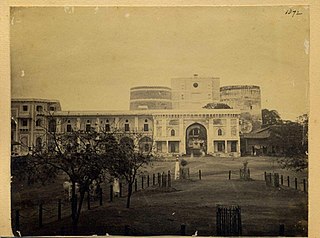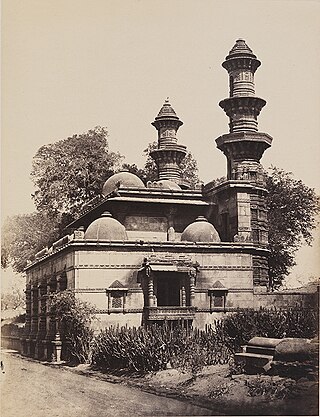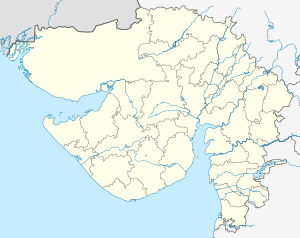
Dara Shikoh, also transliterated as Dara Shukoh, was the eldest son and heir-apparent of the Mughal emperor Shah Jahan. Dara was designated with the title Padshahzada-i-Buzurg Martaba and was favoured as a successor by his father and his elder sister, Princess Jahanara Begum. He had been given the title of 'Shah-e-Buland Iqbal' by Shah Jahan. In the war of succession which ensued after Shah Jahan's illness in 1657, Dara was defeated by his younger brother Prince Muhiuddin. He was executed in 1659 on Aurangzeb's orders in a bitter struggle for the imperial throne.
This page provides a historical timeline of Ahmedabad, the sixth largest city in India.

Indo-Islamic architecture is the architecture of the Indian subcontinent produced by and for Islamic patrons and purposes. Despite an initial Arab presence in Sindh, the development of Indo-Islamic architecture began in earnest with the establishment of Delhi as the capital of the Ghurid dynasty in 1193. Succeeding the Ghurids was the Delhi Sultanate, a series of Central Asian dynasties that consolidated much of North, East, and Central India, and later by the Mughal Empire during the early 16th century. Both of these dynasties introduced Islamic architecture and art styles from West Asia into the Indian subcontinent.

The Gujarat Sultanate or Sultanate of Guzerat was a late medieval Indian kingdom in Western India, primarily in the present-day state of Gujarat. The kingdom was established in 1394 when Muzaffar Shah I, the Governor of Gujarat, declared independence from the Tughlaq dynasty of Delhi.

Safdarjung's tomb is a sandstone and marble mausoleum in Delhi, India. It was built in 1754 in the late Mughal Empire style for Nawab Safdarjung. The monument has an ambience of spaciousness and an imposing presence with its domed and arched red, brown and white coloured structures. Safdarjung, Nawab of Oudh, was made prime minister of the Mughal Empire when Ahmed Shah Bahadur ascended the throne in 1748.
Sarkhej is a suburban neighbourhood in the city of Ahmedabad. It is primarily known for the Sarkhej Roza, an architectural complex located 8 km south from the city centre. One of the most important roads of metropolitan Ahmedabad, Sarkhej–Gandhinagar Highway, originates from Sarkhej and ends at the twin city Gandhinagar.

Sarkhej Roza is a mosque and tomb complex located in the village of Makarba, 7 km south-west of Ahmedabad in Gujarat state, India.

Shaheed Ganj Mosque, originally named the Abdullah Khan Mosque, was a mosque in Lahore, Punjab, Pakistan. The Mosque was commissioned in 1722 during the reign of Mughal Emperor Muhammad Shah and built by Abdullah Khan construction was completed in 1753 during the reign of Ahmad Shah Bahadur. It was constructed next to the shrine of Pir Shah Kaku. Sikh rule began in 1762, the Gurdwara Bhai Taru Singh was built afterwards within the same grounds. The mosque site was under dispute during British rule, but was demolished by Sikhs on the night of 8 July 1935.

Bhadra Fort is situated in the walled city area of Ahmedabad, India. It was built by Ahmad Shah I in 1411. With its well carved royal palaces, mosques, gates and open spaces, it was renovated in 2014 by the Amdavad Municipal Corporation (AMC) and the Archaeological Survey of India (ASI) as a cultural centre for the city.

The Muhafiz Khan Mosque is a fifteenth-century mosque located in the city of Ahmedabad in the Indian state of Gujarat. It is considered to be one of the more exceptional structures in the city. The mosque was constructed in 1465 by Jamail-ud-Din Muhafiz Khan during the reign of Mahmud Shah I (1458-1511), and is considered to be an excellent example of Mughal architecture. It is named for the governor of the region at that time. The mosque is a protected building under the auspices of the Archaeological Survey of India.

Haibat Khan's Mosque is a medieval mosque in Ahmedabad, India.

Saiyad Usman Mosque, alternatively spelled as Syed or Saiyyed, also known as Usmanpura Dargah or Roza or Saiyad Oosman Mausoleum, is a medieval tomb and mosque in Usmanpura, Ahmedabad, India.

Dariya Khan's Tomb or Darya Khan's Dome or Ghummat is a medieval brick tomb in Shahibaug, Ahmedabad, India.

Mir Abu Turab's Tomb, locally known as Qadam-e-Rasul ki Dargah is a medieval tomb in Behrampura, Ahmedabad, India.

Miya Khan Chishti's Mosque and Tomb is a medieval mosque and tomb complex on the bank of Sabarmati river in Shahibaug area of Ahmedabad, India.

Shah-e-Alam's Tomb and Mosque, also known as Rasulabad Dargah or Shah Alam no Rozo, is a medieval mosque and tomb complex (Roza) in Shah Alam area of Ahmedabad, India.

Rani Rupamati's Mosque, also known as Rani Rupavati's Mosque or Mirzapur Queen's Mosque, is a medieval mosque and tomb complex in Mirzapur area of Ahmedabad, India.

The Shrine of Mian Mir is a 17th-century shrine located in Lahore, Pakistan, that is dedicated to the Sufi mystic Mian Mir. The shrine is one of the most celebrated in Lahore, and has historically been revered by both Muslims and Sikhs.
The Mughal Empire's province Gujarat was managed by the Viceroys appointed by the emperors. On the death of the emperor Jahangir, his son Shah Jahan ascended to the throne in 1627. His Gujarat viceroy Sher Khán Túar worked for relief in 1630–32 famine in the province. Shah Jahan sent his men to expand its territories further south. Between 1632 and 1635, four viceroys were appointed due to their precious gift to the emperor and they could not manage the province well. Kolis of Kankrej in north Gujarat committed excesses and the Jam of Nawanagar did not paid the tribute. Soon Azam Khan was appointed who put the province in order by subduing Kolis in north and Kathis in Kathiawad. He also made the Jam of Nawanagar surrender. The next viceroy Ísa Tarkhán carried out financial reforms. In 1644, the Mughal prince Aurangzeb was appointed as the viceroy who was engaged in religious disputes for destroying a Jain temple in Ahmedabad. Due to his disputes, he was replaced by Sháistah Khán who failed to subdue Kolis. So the prince Murad Bakhsh was appointed as the viceroy in 1654. He restored the disorder soon. In 1657, hearing news of Shah Jahan's severe illness, Murad Bakhsh declared himself the emperor and rebelled with his brother Aurangzeb. They defeated the Jaswant Singh and Kásam Khán, whom Sháh Jahán had appointed viceroys of Málwa and Gujarát respectively in the battle of Dharmatpur. They further went to the capital, Agra but were confronted by Dara Shikoh. They defeated him in the Battle of Samugarh (1658). Soon Aurangzed dumped and imprisoned Murad Bakhsh, confined his father and declared himself the emperor in 1658.
The Architecture of Gujarat consists of architecture in the Indian state of Gujarat.




















